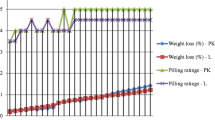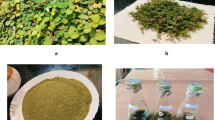Abstract
The research reports moisture management capabilities of the jute/cotton blended fabric before and after enzyme and amino silicone softener treatment. The findings of the results revealed that the enzyme and silicone softener treatment significantly (p<0.05) increased the moisture management characteristics of the jute/cotton fabric irrespective of jute blend proportions. The finished jute/cotton blended union fabric possessed a wetting time (WT) of 6 seconds over the untreated fabric (15 s) on both top and bottom sides. The maximum wetted radius (MWR) of the untreated fabric reduced with respect to the increment in jute percentage in the yarn. In the finished fabric, irrespective of jute proportion the MWR increased to 20 mm/s both top and bottom surface. The absorption rate (AR) of the untreated fabrics noted very high on the top side of the fabric (282 %/s) and less in the bottom side (37 %/s). However, the finished fabric showed a reduced AR on the top side (8 %/s) and higher AR on the backside (51 %/s). Spreading speed (SS) of the untreated fabric noted lesser (0.3 mm/s) than treated (1.2 mm/s). The overall moisture content (OWTC) of the untreated fabric (accumulation of both top and bottom) is rated as very poor and after finishing the fabrics are rated as very good. The Overall moisture management capability (OMMC) of the treated fabric improved from very poor (0.3) to very good (0.6–0.8) designation. Pearson correlation coefficient analysis revealed OMMC values negatively and linearly correlated with OWTC. The findings confirmed that better moisture management behavior of the finished fabric mainly depends on the higher spreading speed and lower wetting time.
Similar content being viewed by others
References
I. M. Mathews, “Mathews Textile Fibres”, p.325, John Wiley and Sons, New York, 1947.
W. A. Bell, BJTRA, 12, 12 (1968).
M. Ali, A. J. Mian, M. N. Islam, M. R. Awual, S. Fazal-E-Karim, and A. M. Sarwaruddin Chowdhury, Indian J. Fibre Text, Res., 26, 414 (2001).
G. Basu and G. A. N. Roya, J. Nat. Fib., 4, 13 (2008).
The World Counts https://www.theworldcounts.com/counters/cotton_environmental_impacts/environmental_issues_with_cotton#top-facts (Accessed August 5, 2019).
A Slow Death, https://blogs.ntu.edu.sg/hp3203-2018-12/2017/11/13/a-slow-death/ (2017) (Accessed August 5, 2019).
UgoDutil, TOP 5, The Best Eco-friendly Fibres, https://respecterre.com/top-5-the-best-eco-friendly-fibres/?lang=en, (2016) (Accessed August 5, 2019).
B. L. Ghosh and A. K. Dutta, J. Text. Inst., 71, 108 (1980).
P. Bajaj, Indian J. Fibe Text. Res., 26, 162 (2001).
A. B. Kundu, B. S. Ghosh, A. K. Dutta, U. K. Ghosh, S. Sengupta, and B. L. Ghosh, Indian J. Fibre Text. Res., 21, 127 (1996).
C. Vigneswaran and J. Jayapriya, J. Text. Inst., 101, 506 (2010).
A. B. Kundu, B. S. Ghosh, and S. K. Chakrabarti, Text. Res. J., 63, 451 (1993).
A. K. Samanta, S. Mitra, and K. K. Mahalanabis, IE(I) Journal-TX, 86, 21 (2006).
M. N. Pattanaik and S. C. Ray, Indian J. Fibre Text. Res., 41, 298 (2016).
L. Ammayappan, S. Debnath, and S. Sengupta, Indian J. Fibre Text. Res., 39, 425 (2014).
A. K. Samanta, S. Mitra Roy, D. Singhee, and P. Samanta, AASCIT J. Mat., 1, 111 (2015).
M. M. Islam, A. Islam, and H. Jiang, Am. J. Polym. Sci. Eng., 3, 129 (2014).
A. K. Samanta, G. Basu, and P. Ghosh, J. Text. Inst., 99, 295 (2008).
G. Basu, A. K. Samanta, and P. Ghosh, J. Text. Inst., 99, 307 (2008).
R. Prathiba Devi, R. Rathinamoorthy, and J. Jeyakodi Moses, J. Text. Assoc., 73, 301 (2013).
R. Prathiba Devi, L. Sasikala, R. Rathinamoorthy, and J. Jeyakodi Moses, Res. J. Text. Appl. Proj., 18, 69 (2014).
Y. Li and Q. Zhu, Text. Res. J., 73, 515 (2003).
T. Karthik, R. Murugan, P. Senthilkumar, Int. J. Cloth. Sci. Tech., 30, 347 (2018).
S. R. Karmakar, “Chemical Technology in the Pretreatment Processes of Textiles”, Elsevier Science B.V. The Netherlands, 1999.
AATCC Test Method 195, “Liquid Moisture Management Properties of Textile Fabrics”, Technical Manual of AATCC, Research Triangle Park, N.C., 271 (2009).
R. Rathinamoorthy, Indian J. Fibe Text. Res., 42, 488 (2017).
P. Kumar, S. Kumar Sinha, and S. Ghosh, Fash. Text., 2, 5 (2015).
M. A. Khan, K. M. Idriss Ali, and S. C. Basm, J. Appl. Polym. Sci., 49, 1547 (1993).
M. M. Ibrahim, A. Dusfrene, W. K. El-Zawawy, and F. A. Agblevor, Carbohydr. Polym., 81, 811 (2010).
I. L. A. da Silva, A. B. Bevitori, L. A. Rohen, F. M. Margem, F. de Oliveira Braga, S. N. Monteiro, Mater. Sci. Forum, 869, 283 (2016).
E. H. Portella, D. Romanzini, C. C. Angrizani, S. C. Amico, and A. J. Zattera, Mat. Res., 19, 542 (2016).
L. M. Johnson, L. Gao, C. W. Shields IV, M. Smith, K. Efimenko, K. Cushing, J. Genzer, and G. P. López, J. Nanobiotech., 11, 22 (2013).
Author information
Authors and Affiliations
Corresponding author
Rights and permissions
About this article
Cite this article
Prathiba Devi, R., Rathinamoorthy, R. & Jeyakodi Moses, J. Analysis on Moisture Management Characteristics of Enzyme and Amino Silicone Treated Jute/Cotton Union Fabric. Fibers Polym 21, 2253–2262 (2020). https://doi.org/10.1007/s12221-020-1072-5
Received:
Revised:
Accepted:
Published:
Issue Date:
DOI: https://doi.org/10.1007/s12221-020-1072-5




